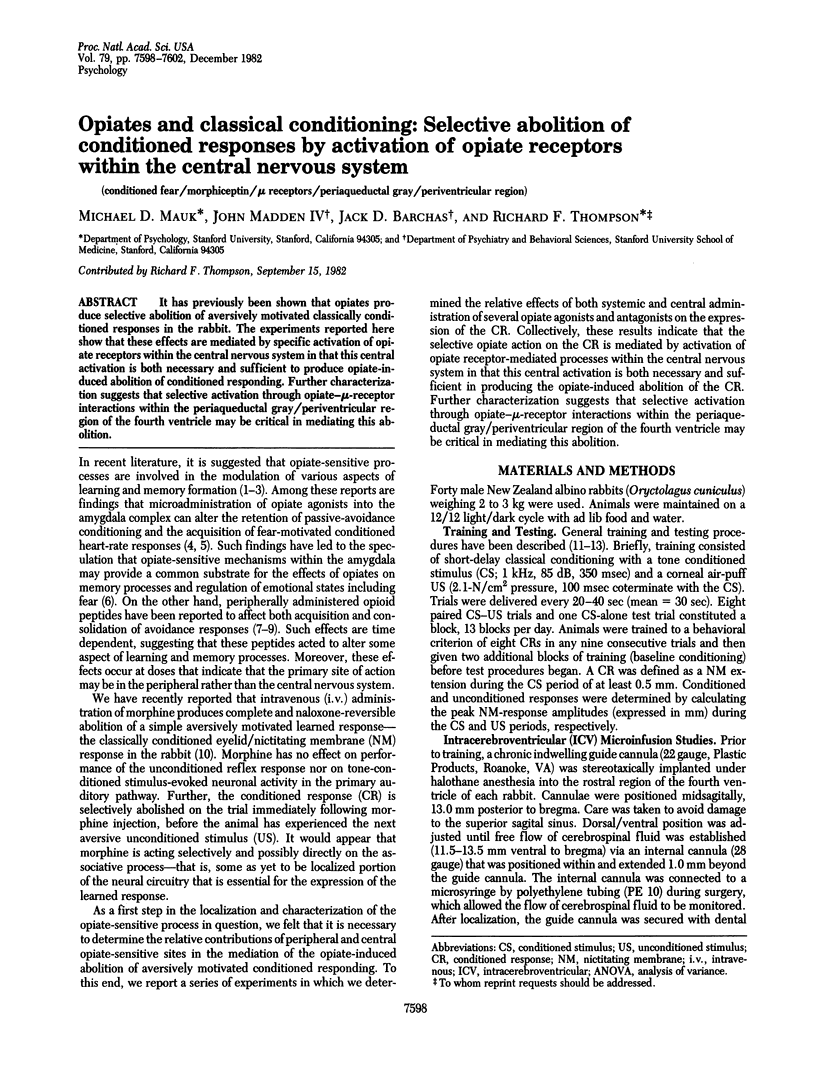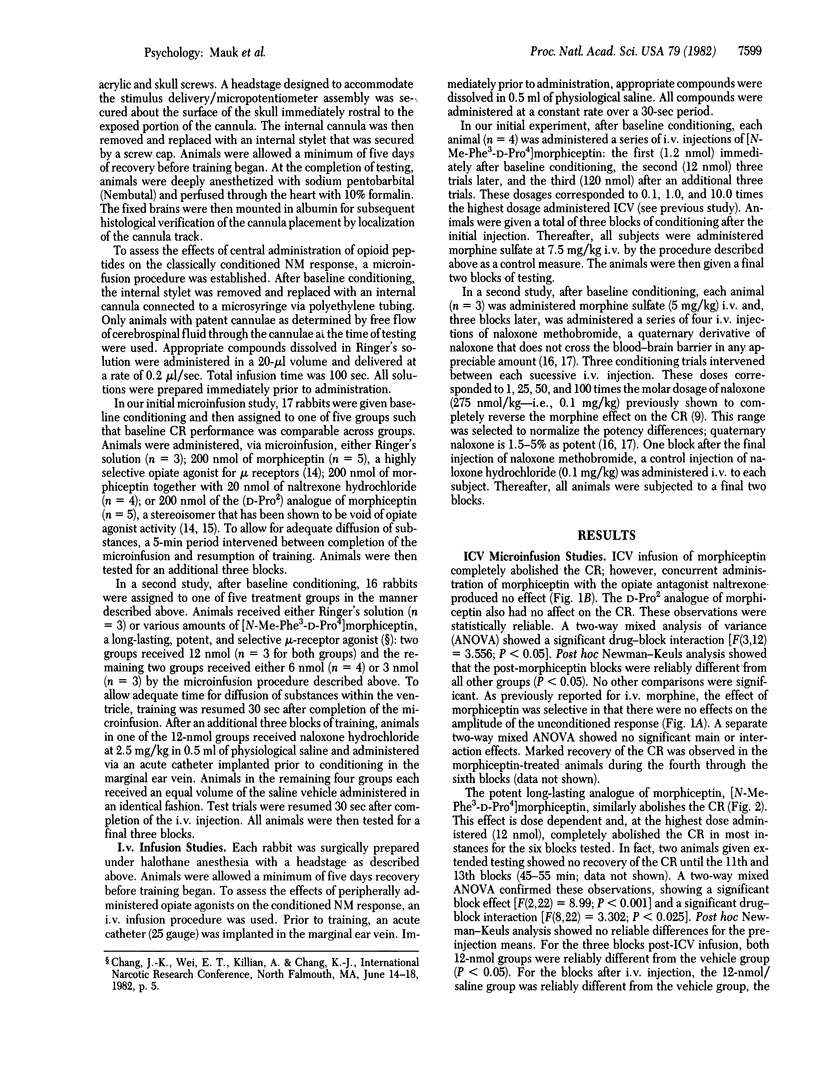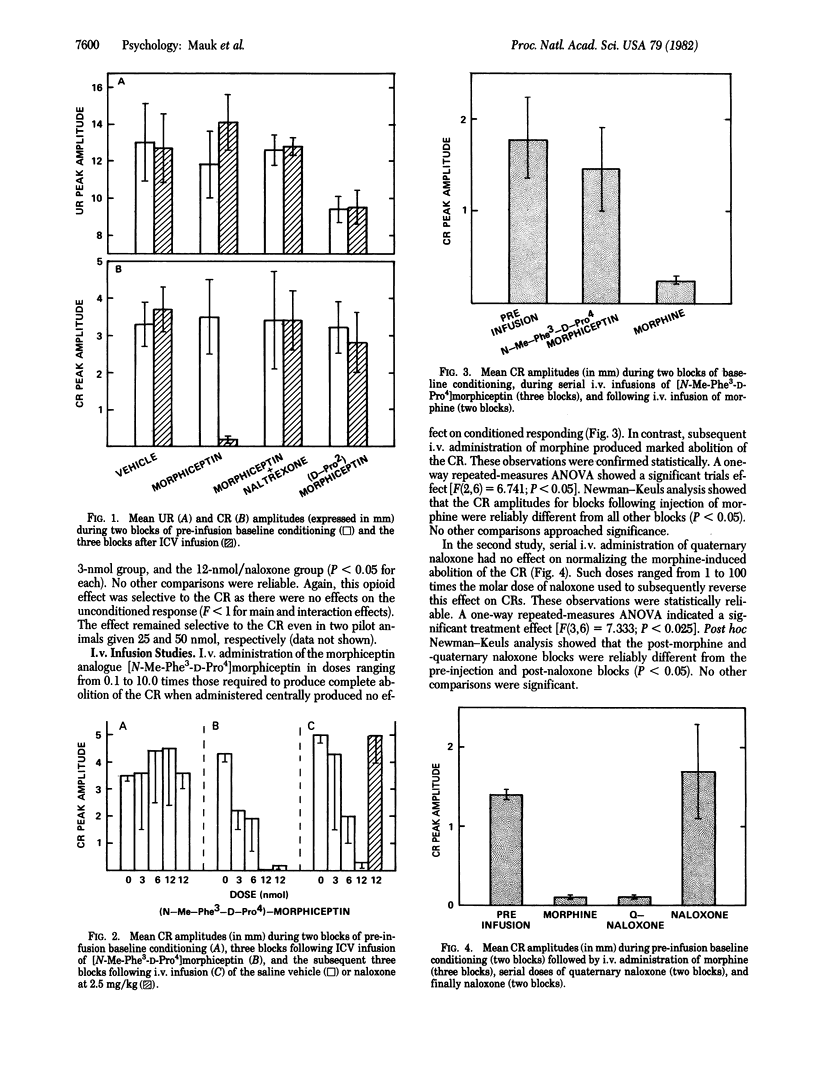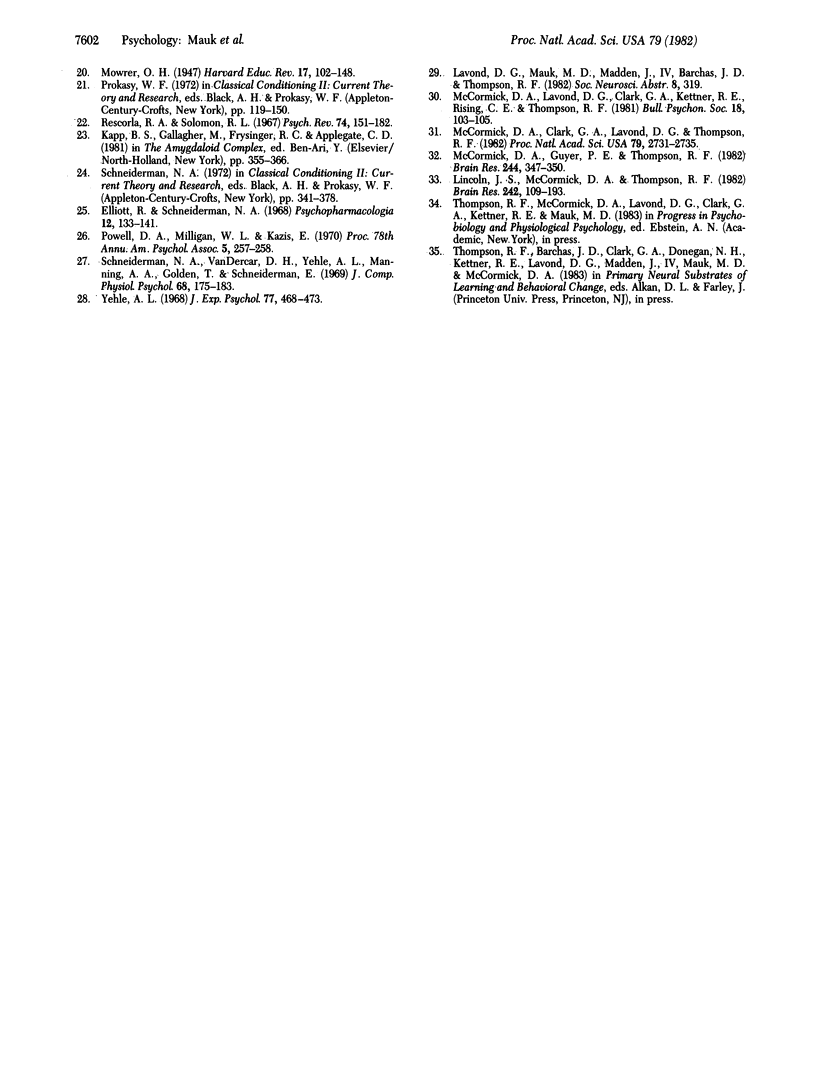Abstract
It has previously been shown that opiates produce selective abolition of aversively motivated classically conditioned responses in the rabbit. The experiments reported here show that these effects are mediated by specific activation of opiate receptors within the central nervous system in that this central activation is both necessary and sufficient to produce opiate-induced abolition of conditioned responding. Further characterization suggests that selective activation through opiate-mu-receptor interactions within the periaqueductal gray/periventricular region of the fourth ventricle may be critical in mediating this abolition.
Full text
PDF




Selected References
These references are in PubMed. This may not be the complete list of references from this article.
- Ahokas H. Cytoplasmic Male Sterility in Barley : VIII. LIPOXYGENASE ACTIVITY AND ANTHER AMINO NITROGEN IN THE msm1-Rfm1a SYSTEM. Plant Physiol. 1982 Jan;69(1):268–272. doi: 10.1104/pp.69.1.268. [DOI] [PMC free article] [PubMed] [Google Scholar]
- Ahokas H. Cytoplasmic Male Sterility in Barley. Xi. the msm2 Cytoplasm. Genetics. 1982 Oct;102(2):285–295. doi: 10.1093/genetics/102.2.285. [DOI] [PMC free article] [PubMed] [Google Scholar]
- Berger T. W., Alger B., Thompson R. F. Neuronal substrate of classical conditioning in the hippocampus. Science. 1976 Apr 30;192(4238):483–485. doi: 10.1126/science.1257783. [DOI] [PubMed] [Google Scholar]
- Berger T. W., Laham R. I., Thompson R. F. Hippocampal unit-behavior correlations during classical conditioning. Brain Res. 1980 Jul 7;193(1):229–248. doi: 10.1016/0006-8993(80)90960-9. [DOI] [PubMed] [Google Scholar]
- Berger T. W., Thompson R. F. Neuronal plasticity in the limbic system during classical conditioning of the rabbit nictitating membrane response. I. The hippocampus. Brain Res. 1978 Apr 28;145(2):323–346. doi: 10.1016/0006-8993(78)90866-1. [DOI] [PubMed] [Google Scholar]
- Bolles R. C., Fanselow M. S. Endorphins and behavior. Annu Rev Psychol. 1982;33:87–101. doi: 10.1146/annurev.ps.33.020182.000511. [DOI] [PubMed] [Google Scholar]
- Chang K. J., Cuatrecasas P., Wei E. T., Chang J. K. Analgesic activity of intracerebroventricular administration of morphiceptin and beta-casomorphins: correlation with the morphine (micro) receptor binding affinity. Life Sci. 1982 May 3;30(18):1547–1551. doi: 10.1016/0024-3205(82)90242-9. [DOI] [PubMed] [Google Scholar]
- Chang K. J., Lillian A., Hazum E., Cuatrecasas P., Chang J. K. Morphiceptin (NH4-tyr-pro-phe-pro-COHN2): a potent and specific agonist for morphine (mu) receptors. Science. 1981 Apr 3;212(4490):75–77. doi: 10.1126/science.6259732. [DOI] [PubMed] [Google Scholar]
- Elliott R., Schneiderman N. Pentylenetrazol: facilitation of classical discrimination conditioning in rabbits. Psychopharmacologia. 1968;12(2):133–141. doi: 10.1007/BF00401543. [DOI] [PubMed] [Google Scholar]
- Gallagher M., Kapp B. S. Manipulation of opiate activity in the amygdala alters memory processes. Life Sci. 1978 Nov 9;23(19):1973–1977. doi: 10.1016/0024-3205(78)90565-9. [DOI] [PubMed] [Google Scholar]
- Gallagher M., Kapp B. S., McNall C. L., Pascoe J. P. Opiate effects in the amygdala central nucleus on heart rate conditioning in rabbits. Pharmacol Biochem Behav. 1981 Apr;14(4):497–505. doi: 10.1016/0091-3057(81)90309-9. [DOI] [PubMed] [Google Scholar]
- Herz A., Albus K., Metys J., Schubert P., Teschemacher H. On the central sites for the antinociceptive action of morphine and fentanyl. Neuropharmacology. 1970 Nov;9(6):539–551. doi: 10.1016/0028-3908(70)90004-3. [DOI] [PubMed] [Google Scholar]
- Kende H. KINETINLIKE FACTORS IN THE ROOT EXUDATE OF SUNFLOWERS. Proc Natl Acad Sci U S A. 1965 Jun;53(6):1302–1307. doi: 10.1073/pnas.53.6.1302. [DOI] [PMC free article] [PubMed] [Google Scholar]
- Letham D. S., Wilson ?MM, Parker C. W., Jenkins I. D., Macleod J. K., Summons R. E. Regulators of cell division in plant tissue. XXIII. The identity of an unusual metabolite of 6-benzylaminopurine. Biochim Biophys Acta. 1975 Jul 14;399(1):61–70. doi: 10.1016/0304-4165(75)90211-1. [DOI] [PubMed] [Google Scholar]
- Lincoln J. S., McCormick D. A., Thompson R. F. Ipsilateral cerebellar lesions prevent learning of the classically conditioned nictitating membrane/eyelid response. Brain Res. 1982 Jun 17;242(1):190–193. doi: 10.1016/0006-8993(82)90510-8. [DOI] [PubMed] [Google Scholar]
- Martinez J. L., Jr, Rigter H. Endorphins alter acquisition and consolidation of an inhibitory avoidance response in rats. Neurosci Lett. 1980 Sep;19(2):197–201. doi: 10.1016/0304-3940(80)90194-9. [DOI] [PubMed] [Google Scholar]
- Mauk M. D., Warren J. T., Thompson R. F. Selective, naloxone-reversible morphine depression of learned behavioral and hippocampal responses. Science. 1982 Apr 23;216(4544):434–436. doi: 10.1126/science.7071592. [DOI] [PubMed] [Google Scholar]
- McCormick D. A., Clark G. A., Lavond D. G., Thompson R. F. Initial localization of the memory trace for a basic form of learning. Proc Natl Acad Sci U S A. 1982 Apr;79(8):2731–2735. doi: 10.1073/pnas.79.8.2731. [DOI] [PMC free article] [PubMed] [Google Scholar]
- McCormick D. A., Guyer P. E., Thompson R. F. Superior cerebellar peduncle lesions selectively abolish the ipsilateral classically conditioned nictitating membrane/eyelid response of the rabbit. Brain Res. 1982 Jul 29;244(2):347–350. doi: 10.1016/0006-8993(82)90095-6. [DOI] [PubMed] [Google Scholar]
- Miller C. O. Cytokinin inhibition of respiration in mitochondria from six plant species. Proc Natl Acad Sci U S A. 1980 Aug;77(8):4731–4735. doi: 10.1073/pnas.77.8.4731. [DOI] [PMC free article] [PubMed] [Google Scholar]
- Morris R. O. Mass Spectroscopic Identification of Cytokinins: Glucosyl Zeatin and Glucosyl Ribosylzeatin from Vinca rosea Crown Gall. Plant Physiol. 1977 Jun;59(6):1029–1033. doi: 10.1104/pp.59.6.1029. [DOI] [PMC free article] [PubMed] [Google Scholar]
- Olson G. A., Olson R. D., Kastin A. J., Coy D. H. Endogenous opiates: 1979(1). Peptides. 1980 Winter;1(4):365–379. doi: 10.1016/0196-9781(80)90016-9. [DOI] [PubMed] [Google Scholar]
- Peterson J. B., Miller C. O. Glucosyl Zeatin and Glucosyl Ribosylzeatin from Vinca rosea L. Crown Gall Tumor Tissue. Plant Physiol. 1977 Jun;59(6):1026–1028. doi: 10.1104/pp.59.6.1026. [DOI] [PMC free article] [PubMed] [Google Scholar]
- Rescorla R. A., Solomon R. L. Two-process learning theory: Relationships between Pavlovian conditioning and instrumental learning. Psychol Rev. 1967 May;74(3):151–182. doi: 10.1037/h0024475. [DOI] [PubMed] [Google Scholar]
- Rigter H., Hannan T. J., Messing R. B., Martinez J. L., Jr, Vasquez B. J., Jensen R. A., Veliquette J., McGaugh J. L. Enkephalins interfere with acquisition of an active avoidance response. Life Sci. 1980 Feb 4;26(5):337–345. doi: 10.1016/0024-3205(80)90149-6. [DOI] [PubMed] [Google Scholar]
- Riley A. L., Zellner D. A., Duncan H. J. The role of endorphins in animal learning and behavior. Neurosci Biobehav Rev. 1980 Spring;4(1):69–76. doi: 10.1016/0149-7634(80)90026-3. [DOI] [PubMed] [Google Scholar]
- Schneiderman N., Van Dercar D. H., Yehle A. L., Manning A. A., Golden T., Schneiderman E. Vagal compensatory adjustment: relationship to heart rate classical conditioning in rabbits. J Comp Physiol Psychol. 1969 Jun;68(2):175–183. doi: 10.1037/h0027514. [DOI] [PubMed] [Google Scholar]
- Tal M., Imber D., Itai C. Abnormal Stomatal Behavior and Hormonal Imbalance in flacca, a Wilty Mutant of Tomato: I. Root Effect and Kinetin-like Activity. Plant Physiol. 1970 Sep;46(3):367–372. doi: 10.1104/pp.46.3.367. [DOI] [PMC free article] [PubMed] [Google Scholar]
- Valentino R. J., Herling S., Woods J. H., Medzihradsky F., Merz H. Quaternary naltrexone: evidence for the central mediation of discriminative stimulus effects of narcotic agonists and antagonists. J Pharmacol Exp Ther. 1981 Jun;217(3):652–659. [PubMed] [Google Scholar]
- Yehle A. L. Divergences among rabbit response systems during three-tone classical discrimination conditioning. J Exp Psychol. 1968 Jul;77(3):468–473. doi: 10.1037/h0025985. [DOI] [PubMed] [Google Scholar]
- van Staden J., Dimalla G. G. Endogenous Cytokinins in Bougainvillea ;San Diego Red': I. OCCURRENCE OF CYTOKININ GLUCOSIDES IN THE ROOT SAP. Plant Physiol. 1980 May;65(5):852–854. doi: 10.1104/pp.65.5.852. [DOI] [PMC free article] [PubMed] [Google Scholar]


